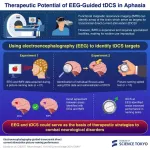(Press-News.org) BUFFALO, N.Y. — A small percentage of patients taking the extraordinarily popular GLP-1 medications have experienced vision problems, but a direct causal link with the drugs has not been established. That is the conclusion of a retrospective study published online on Jan. 30 in JAMA Ophthalmology.
The study focused on nine patients who had experienced vision problems while using semaglutide (brand names Wegovy and Ozempic) and tirzepatide (brand names Mounjaro and Zepbound).
The paper is one of several in the past year that have documented vision problems in patients using these drugs. Several patients have presented with a medical condition called nonarteritic anterior ischemic optic neuropathy (NAION), a non-inflammatory disease of small blood vessels in the anterior portion of the optic nerve. The condition occurs when blood supply to the optic nerve is insufficient, damaging the nerve and resulting in sudden partial vision loss that is usually permanent.
The recent JAMA study came about when senior author Bradley J. Katz, MD, of the John A. Moran Eye Center at University of Utah Health, saw a patient who experienced sudden painless vision loss after starting semaglutide. The patient stopped using the drug briefly but then experienced the same thing in the other eye when the internist put the patient back on the drug.
That prompted Katz to post a question on a national neuro-ophthalmology listserv to see if his colleagues were seeing similar things in their patients. Neuro-ophthalmology merges the fields of neurology and ophthalmology, often dealing with complex systemic diseases that manifest in the vision system.
Feedback from neuro-ophthalmologists
The nine cases described in the paper are the result of feedback Katz received from his colleagues in neuro-ophthalmology.
“We’re trying to elucidate if being on these drugs can increase your risk,” says Norah S. Lincoff, MD, a co-author on the paper and professor of neurology in the Jacobs School of Medicine and Biomedical Sciences at the University at Buffalo. She is the neuro-ophthalmologist at UBMD Neurology.
The paper reports that seven of the nine patients had a NAION-like presentation; one had papillitis, which is inflammation of the optic nerve head; and one had a condition called paracentral acute middle maculopathy, which can cause a blind spot in one’s vision. Some of the patients had atypical symptoms. For example, while NAION nearly always presents only in one eye at a time, some patients presented with it in both eyes at the same time.
The authors point out that other classes of drugs, including those treating erectile dysfunction and an anti-arrythmic drug, have previously been found to cause NAION in some patients; some of those have led to labeling changes on the drugs.
While reports of patients on semaglutide and tirzepatide with vision problems are still rare, there are concerns, the authors say, because demand for the drugs is skyrocketing. A 2024 study reported that 12% of the U.S. population has ever taken one of these drugs and that approximately 6% of the population is currently taking them.
Comorbidities are a factor
The patients, all in their 50s and 60s, were prescribed these drugs in the first place because they have diabetes or obesity, as well as other cardiovascular comorbidities, which can by themselves cause diabetic retinopathy, blurring or other vision issues.
“So are these drugs increasing the risk for an episode of visual loss?” Lincoff asks. She adds that a rapid reduction in blood glucose levels, which is the goal of these drugs, may put these patients at higher risk.
And she notes it is well-known that diabetic patients who aren’t on these drugs may have blurring for an hour or two because fluctuations in blood sugar can affect vision temporarily.
“The message to the patient is that we are still investigating if these drugs put them at higher risk of ischemic optic nerve damage,” says Lincoff. “The message to the primary care provider is, if a patient on one of these medications calls you and says that there is blurring or vision loss, have them see their ophthalmologist as soon as possible. Don’t wait. Maybe it’s a fluctuation in glucose or it could be something more serious.”
She adds that because these drugs provide well-documented benefits, people should not randomly decide to go off them. But if a patient taking these drugs experiences vision loss, they should call their internist about possibly adjusting the dosage or stopping the medication.
“We have other ways to control diabetes and weight loss,” she says. “There are many options for patients.”
She adds that the authors are joining with the American Academy of Ophthalmology in recommending a post-marketing survey to more accurately assess the number of patients receiving these drugs who experience an adverse ocular reaction.
END
Ophthalmic complications in patients on antidiabetic GLP-1 medications are concerning neuro-ophthalmologists
2025-02-06
ELSE PRESS RELEASES FROM THIS DATE:
Physicians committee research policy director speaks today at hearing on taxpayer funded animal cruelty
2025-02-06
WASHINGTON, D.C. — Research Policy Director Elizabeth Baker from the Physicians Committee for Responsible Medicine, a national medical ethics and health advocacy group of 17,000 physicians, spoke today, Feb. 6, at a Congressional hearing focused on ending federally funded animal cruelty in research.
The U.S. House Oversight and Government Reform Subcommittee on Cybersecurity, Information Technology, and Government Innovation Chairwoman Nancy Mace (R-S.C.) announced the hearing in a news release on Monday, with plans to evaluate current animal cruelty funded by the federal government and explore opportunities ...
New technology lights way for accelerating coral reef restoration
2025-02-06
COLUMBUS, Ohio – Scientists have developed a novel tool designed to protect and conserve coral reefs by providing them with an abundance of feeding opportunities.
The device, dubbed the Underwater Zooplankton Enhancement Light Array (UZELA), is an autonomous, programmable underwater light that works to draw in nearby zooplankton, microscopic organisms that coral feed on.
After testing the submersible on two species of coral native to Hawaii over six months, researchers found that UZELA could ...
Electroencephalography may help guide treatments for language disorders
2025-02-06
Electroencephalography (EEG) may offer a more accessible alternative to functional magnetic resonance imaging (fMRI) for guiding transcranial direct current stimulation (tDCS) when treating aphasia. Researchers from Institute of Science Tokyo found an 80% agreement between EEG and fMRI in identifying brain regions activated during language tasks. Furthermore, EEG-guided tDCS improved picture-naming speed in participants, indicating its potential for innovative therapies in language disorders.
Many neurological disorders are directly linked to damage or deterioration in specific regions of the brain. For example, ...
Multinational research project shows how life on Earth can be measured from space
2025-02-06
Measurements and data collected from space can be used to better understand life on Earth.
An ambitious, multinational research project funded by NASA and co-led by UC Merced civil and environmental engineering Professor Erin Hestir demonstrated that Earth’s biodiversity can be monitored and measured from space, leading to a better understanding of terrestrial and aquatic ecosystems. Hestir led the team alongside University of Buffalo geography Professor Adam Wilson and Professor Jasper Slingsby from the University ...
Essential genome of malaria parasite Plasmodium knowlesi mapped
2025-02-06
Embargoed for release: Thursday, February 6, 2025, 2:00 PM ET
Key points:
Comprehensive genetic mapping of Plasmodium knowlesi, a zoonotic parasite that causes malaria, has revealed the genes required for malaria infection of the blood, and those driving drug resistance.
By identifying specific druggable targets and determinants of resistance, the map provides insights that could help the development of new therapeutics.
Boston, MA—A new, comprehensive map of all the genes essential for blood infections in Plasmodium knowlesi (P. ...
Ice streams move due to tiny ice quakes
2025-02-06
In brief:
• In Greenland, an international team of researchers led by ETH Zurich has discovered that countless tiny ice quakes take place deep inside ice streams.
• These quakes are responsible for the fact that ice streams also move with a continuous stick-slip motion and not only like viscous honey as previously considered.
• The researchers recorded seismic data from inside the ice stream using a fibre-optic cable in a 2,700-metre deep borehole.
The ...
Whale song has remarkable similarities to human speech in terms of efficiency
2025-02-06
Whale song can be as efficient as – and, in some cases, more efficient than – human communication, according to a new study in Science Advances. Meanwhile, new unrelated research in Science further investigates whale song’s adherence to a universal linguistic law, as observed in recordings of humpback whales.
Natural selection favors the pithy over the longwinded. For example, yelling “Duck!” is faster and far more effective than shouting “Be careful, there is an incoming projectile, and you need to move out of the way!” ...
Uncovered: How mice override instinctive fear responses
2025-02-06
Researchers have uncovered a neural mechanism in the brains of mice that enables them to override instinctive fear responses; dysfunction in this mechanism may contribute to inappropriate or excessive fear responses, they say. According to the findings, targeting these circuits could offer new therapeutic avenues for treating fear-related disorders like post-traumatic stress disorder and anxiety. Fear responses to visual threats, such as escaping from an approaching predator, are critical instinctive reactions for survival and are ...
A pathway that contributes to insulin resistance can be targeted, mouse study shows
2025-02-06
The hormone adrenomedullin disrupts insulin signaling in blood vessel cells, contributing to systemic insulin resistance in obesity-associated type 2 diabetes, according to a new study. Blocking adrenomedullin’s effects restores insulin function and improves glucose control in a mouse model, suggesting a potential new target for treating obesity-related metabolic disease. Diabetes is a leading global cause of illness, mortality, and healthcare expenditures, with most cases stemming from obesity-induced insulin resistance and type 2 diabetes mellitus. Insulin resistance primarily ...
Special Issue: The cryosphere
2025-02-06
In this Special Issue of Science, 3 Reviews and a Policy Forum highlight research on Earth’s frozen places – from the Arctic to the Antarctic – and how it’s changing due to climate change and the geopolitical challenges this important work faces. In the first Review, Julienne Stroeve and colleagues provide a preview of what the Arctic region may look like in a warmer world. Without stronger climate action, global temperatures are set to rise +2.7°C above preindustrial levels, ...



